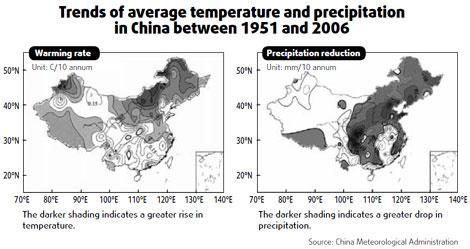
As a result of climate change, droughts will continue to plague northern China for decades to come, according to some scientists and meteorologists.
This winter, northern China has witnessed its worst drought in more than five decades. The dry spell since last November has affected about 10.7 million hectares of farmland, leaving at least 3.46 million people short of water, according to the Ministry of Agriculture.
Meteorologists said that the current drought is a result of the stagnancy of cold air in the north of the Yangtze River.
The drought is due to the prevalence of cold air in the north since last November, while warm and humid airflows from the south remain weak, according to Yang Guiming, chief forecaster of the National Meteorological Center (NMC).
But how climate change has contributed to the drought still cannot be determined at the moment.
"Previous research found that climate change has intensified atmospheric circulation in southern China," said Lin Erda, who led a key national lab on agro-environment and climate change under the ministry.
"But this year, it's different."
"What we can be sure of is that this prolonged drought, an extreme climate event, is happening against the backdrop of climate change," Lin said.
China's National Report on Assessment of Climate Change, published in 2006, said the global warming has aggravated water shortages in northern China.
The annual average air temperature in China rose by about 1.1 C over the past 50 years, with a warming rate of about 0.22 C per decade, more rapid than the global rate.
Northern China experienced more significant warming in terms of annual average temperature, which contributed to evaporation in the area.
Although no significant change was recorded in the country's average annual precipitation, inter-regional differences have increased over the past 100 years, with rainfall declining 20-40 mm per decade in the north, and rising 20-60 mm per decade in the south.
Over the past 20 years, mainstream waterflows have declined by 41 percent in the Haihe River basin, 15 percent in the Yellow River basin, 15 percent in the Huaihe River basin, and 9 percent in the Liaohe River basin.
A number of serious droughts have taken place over the past decade.
The drought running through the winter of 1998 and the spring of 1999 had a more severe impact than this year's, according to Zhang Peiqun, director of the NMC's climate forecast office.
"During the past decade, only 2004 and 2008 recorded a normal level of rainfall, precipitation has been limited in the other years," Zhang was quoted as saying by China Business News.
Meteorologists have predicted that the dry weather is likely to continue in northern China in the coming decade. And even with increased rainfall after 2020, the overall impact of climate change is unlikely to relieve the water shortage in the area.
Fu Congbin, an academician at the Chinese Academy of Sciences, who led a research on the forecasting of aridity trends in northern China, said that droughts have been prevalent in the region through the first years of the new century.
During the second decade of the 21st century, droughts will be slightly less severe in the northeast and north, while the eastern part of Northwest will start to get wet.
Between 2020 and 2050, the northern part of China will become more humid, but the southern part of northern China will remain relatively dry.
"Even if there is more rainfall in the 2030s, the precipitation level is unlikely to rise dramatically," said Lin, "it is only going back to the level of 1960s or 1970s, when northern China was in a relative wet period."
"For instance, Beijing's annual precipitation in the 1960s was about 600 mm, now it is about 500 mm."
"Even if the precipitation goes back to the previous level, the northern part of China will still suffer from water shortages, considering that water consumption has greatly increased in recent years, with the trend set to continue in the following years," said Lin.
Also, while the total annual precipitation will increase to some extent, the warming trend will result in higher evaporation.
It is estimated that average nationwide temperatures will increase by 1.3 C to 2.1 C by 2020, 1.5 C to 2.8 C by 2030, and 2.3 C to 3.3 C by 2050.
"Taking this into account, the water shortage in northern China is unlikely to ease in the near future," said Lin.
Source: China Daily
Related News
Photos
More>>trade
- YRCC Delegation Participated in the UNESCO and INBO Sessions of the 5th World
- Mr. Xu Cheng met with Officials from International Water Institutions and
- YRCC Delegation Participated in the Opening Ceremony of the 5th World Water
- Experience of Yellow River Management embodied by the Third UN World Water
- Drought's effects worst in Gansu





